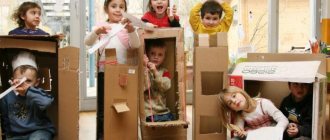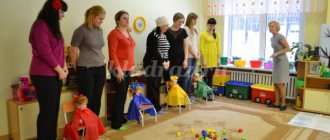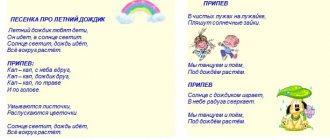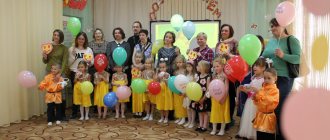Long-term entertainment plan for the first junior group
Entertainment plan for the first junior group
September
- "Guys' Holiday"
Goal: to put children in a good mood by listening and singing along to children's songs from cartoons. Offer to move to the music with handkerchiefs and rattles.
- "Funny toys"
Goal: developing children's knowledge about caring for toys and handling them correctly; learn to answer questions based on the text; create a good mood, a positive emotional state; enrich your vocabulary.
- Video library. Fairy tale "Ryaba Hen"
Goal: to put children in a good mood from watching a presentation of a fairy tale. Learn to answer questions. Offer to mold the grains for the chicken. Cultivate a love for Russian folklore.
- physical education "Visiting the bear"
Goal: to exercise children in walking and running. Improve crawling and jumping skills. Continue to expand children's knowledge about autumn. Give children a feeling of joy.
October
1. “Visiting the bear”
Goal: to exercise children in walking and running. Improve crawling and jumping skills. Continue to expand children's knowledge about autumn. Give children a feeling of joy.
2.
Video library.
Fairy tale “Turnip” Purpose: to put children in a good mood from watching the presentation of the fairy tale. Learn to answer questions. Offer to build a path of bricks for the woman and grandfather.
3. Musical and theatrical “Cat with Kittens”
Goal: to make children want to emotionally interact with adults. Encourage children to actively participate in the activity. Continue to introduce the habits of cats and kittens.
- Musical and theatrical “The doll Masha has a birthday”
Goal: to help children remember the sequence of dressing and feeding. Continue introducing the names of cookware. Develop interest in play. Cultivate a caring attitude towards the doll.
November
- Physical education "Our Teremok"
(Kolesnikova, p. 24) Purpose: To train children in running and jumping; stimulate speech activity. Foster a love of playing together.
(Kolesova, p. 24)
- Cognitive and research “Who came to visit?”
Goal: To awaken children's interest in small folk forms of oral folk art. Involve children in communication with adults and peers. Develop children's individual creative abilities through modeling. Consolidate knowledge of familiar nursery rhymes.
- Musical and theatrical "Russian Matryoshka"
Goal: To introduce children to Russian folk art using the example of folk toys. Evoke positive emotions. Encourage participation in games and round dances.
- “The kids congratulate mom”
Goal: To enrich children's musical experience. Create a joyful mood in them. Develop the ability to move rhythmically to music.
December
- Physical education and recreation “My funny ringing ball”
Goal: To develop endurance, muscle strength, and agility in children. Exercise children in performing movements with the ball. Act on a signal. Give children pleasure.
- Video library “Christmas tree in the forest”
Goal: To make children want to see a Christmas tree in the forest (using slides). Make you want to sing along to the song “Little Christmas Tree”. Develop musicality and sense of rhythm.
- Educational and research “Winter walk”
Goal: To consolidate children's knowledge about the winter season. Develop cognitive activity: find snow, ice. Learn to perform movements to music. Develop a sense of rhythm
- “Santa Claus brought a Christmas tree for the children”
January
- Physical education and recreation “Outdoors in winter”
Goal: to give children pleasure from playing outdoors. Exercise children in jumping up while reaching for an object. Develop the ability to throw snowballs into the distance with your right and left hands. Practice balance (stop quickly when given a signal). Develop dexterity and patience.
- Musical and theatrical “Farewell to the Christmas tree”
Goal: To make children want to have fun at the Christmas tree: sing songs, dance, play
- Educational and research “Pills grow on a branch, pills grow in a garden bed.”
Goal: To clarify children’s knowledge about vegetables and fruits, their qualities, to consolidate the ability to recognize them from a picture and give a short description.
February
- Musical and theatrical "About the red fox"
Goal: to make children want to sing and play with a fairy-tale character, to participate in the staging of the nursery rhyme “Once a fox went into the forest.” Develop perception, speech, communication skills
- "Funny toys."
Goal: to develop children’s knowledge about caring for toys and handling them correctly; learn to answer questions based on the text; create a good mood, a positive emotional state; enrich your vocabulary.
- “Visiting Alyonushka”
Goal: Continue to introduce children to Russian folklore. Make children want to play on wooden spoons and admire their beauty. Develop musical and rhythmic movements.
- Physical education “The locomotive hummed”
Goal: To develop in children the ability to play outdoor games, run fast, jump, and throw balls into the distance. Be dexterous and brave.
March
- Musical and theatrical Festival “Congratulations to Mommy”
Goal: to make children want to sing, play, have fun and congratulate their mother. Develop emotional responsiveness, enrich musical experience.
- Musical and theatrical “Grandma Arina came to visit us”
»
Goal: Create an atmosphere of joyful mood. Teach children to solve riddles, read poems and sing songs together with a fairy-tale character.
- Educational and research "Rainbow Holiday"
Goal: to bring joy to children, to cause a storm of emotions. Development of dexterity, coordination of movements, the ability to distinguish colors and the size of the number of objects (soap bubbles).
- Physical education "Visiting a fairy tale"
Goal: To make children want to be participants in fairy-tale events. Develop the ability to maintain a stable body position and correct posture;
April
- Musical and theatrical "April Fool's Day"
Goal: to evoke positive emotions, good mood. Teach children to play outdoor games together, jump, run, without bumping into each other. Develop perception, coordination of movements, dexterity.
- Sports and recreational “Visiting the Hedgehog”
Purpose: to exercise children in walking and running; improve crawling and jumping skills; continue to expand children's knowledge about nature; give children a feeling of joy.
- Presentation of the fairy tale
“Kolobok”
Goal: to put children in a good mood from watching a presentation of a fairy tale. To teach them to answer questions. Offer to mold the grains for the chicken. Cultivate a love for Russian folklore.
- Cognitive and research “And on the hands there are fingers, girls and boys”
Goal: To involve children in communication with adults and peers. Develop children's individual creative abilities through modeling. Consolidate knowledge of familiar nursery rhymes.
May
- Musical and theatrical "Sunny Bunnies"
Goal: Develop communication skills. Continue to introduce basic rules of conduct, ethics of greeting and communication.
- Physical education and recreation “We grow healthy”
Goal: To evoke in children an emotional response to the gaming activity and a desire to participate in it. Teach children to play together. Teach more dexterous children to help other kids.
Teach children to sympathize and empathize with a fairy-tale character.
- Video library Fairy tale “Turnip”
Goal: to put children in a good mood from watching a presentation of a fairy tale. Learn to answer questions. Offer to build a bridge and a path to the woman and grandfather's house.
- Educational and research "Circus"
Goal: To learn to identify the features of objects and natural objects based on the techniques of sensory examination, comparison, elementary analysis and generalization. To promote mastery of various actions with objects. To promote the development of interest in participating in game improvisations.
TOP toys
When choosing educational games and aids for a nursery group, you need to pay attention to their functionality, developmental focus, age-appropriateness and safety. When evaluating toys for primary preschool age, we considered precisely these criteria. The top positions in the ranking included:
- constructors with 25-30 large parts;
- classic pyramids with 4-5 rings and one pin;
- puzzles consisting of 4-6 fragments;
- frames with images of animals, fruits, vegetables, transport;
- sorters with a base in the form of a container with holes;
- business boards based on Russian folk tales;
- lacing rollers;
- lacing beads;
- labyrinths with multiple routes;
- musical instruments: metallophone, xylophone;
- themed lotto.
In addition to the didactic games necessary for children in the nursery group, they must have items for active activities. Among the popular ones:
- balls of different sizes;
- hoops;
- jump ropes;
- ring throwers;
- throwing bags;
- bowling sets.
We must not forget about materials for creativity: finger and regular paints, easels, plasticine, applique kits.
Heels and toes
The guys are divided into equal numbers of team members. Each team stands in a separate row (one after the other). At the same distance from each team there is a chair with the same number of candies (the number of candies is equal to the number of team members). The presenter explains a simple rule: the first participants run on their toes, the second - on their heels, the third on their toes, the fourth - on their heels, and so on through one on their toes - on their heels. At the command “start”, the first participants run on their tiptoes to their chair, take the candy and run back to their team, pass the baton to the second participants and stand at the end of the team. Then the second participants run, only on their heels, take the candy and back to their team, pass the baton and stand at the end of the team. The team that runs faster than the rest on their toes and heels and collects all their candies, and the first participant in the team will again be in first place and become the winner.
Apchhi
Everyone can participate in turn. The first person to come is invited and is blindfolded. Then the host points his finger at any guest, and he must imitate “apchhi” - sneeze. And the participant with his eyes closed must recognize the sneezing person by this sound and say his name, then the host points his finger at the other guest, he sneezes, the participant guesses, and so on 3 more times. The number of sneezes the participant can guess is how many points he will receive. Then the next participant is invited to participate. For him, too, 5 different guys take turns sneezing. And the participant guesses them by the sound “apchhi”. And in the end, the participant with the most points will be the winner.
Safety requirements
Any toy must have a quality certificate, be safe and not pose a threat to health. Among the mandatory requirements:
- no rust, traces of insects, visible damage;
- materials, including finishing (paint, varnish) - non-toxic;
- parts and surfaces should not have hard sharp edges or burrs;
- the top protective layer must withstand the effects of saliva and wet processing;
- absence of glass, porcelain, pile materials, filling with granules less than 3 mm in diameter;
- part size more than 4-5 cm;
- structural elements must be securely fastened;
- musical instruments should have a pleasant sound.
When purchasing toys, you need to carefully consider the packaging. The following should be indicated here: the name of the manufacturer, his details, the recommended age for which it is intended, operating instructions and date of manufacture.
Well-chosen games for the garden, in particular for the nursery group, help organize the correct subject-spatial environment necessary for the effective development of children. But this is only half the success. Children will need help and guidance from adults. After all, two or three year olds are not yet able to use all the learning potential inherent in toys.
Dump truck
For this competition, you will need to provide each participant with a dump truck (you can buy identical small cars in a children's toy store). Near each participant there will be an identical pile of candies, for example. Each participant, at the command “start,” puts one candy in the back and carries it in the car along the floor to his mark (on the same line for everyone). Then he unloads the candy and goes for the next one. The first participant to transport all the candies on a dump truck will win and receive a prize.




